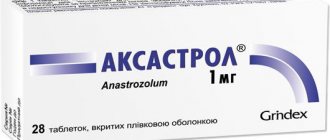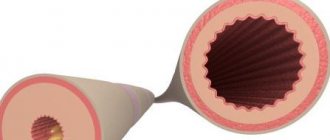Pharmacological properties of the drug Penester
The development of benign prostatic hyperplasia (BPH) is caused by the transformation of the hormone testosterone into its more active analogue - dihydrotestosterone, which stimulates prostatic hyperplasia. Finasteride selectively inhibits one of the intracellular enzymes (5 α-reductase), which transforms testosterone into dihydrotestosterone. Thus, finasteride reduces the level of dihydrotestosterone in the blood. As a result, the growth of prostate tissue slows down. In patients, the volume of the prostate gland decreases and urination is normalized. After oral administration, finasteride is absorbed relatively slowly. Its peak concentration in blood plasma is reached 2 hours after administration. The bioavailability of finasteride after oral administration is 63%. Approximately 93% of the drug binds to plasma proteins. The half-life is 6 hours, although with age (in patients over 70 years of age) it can increase to 8 hours. Finasteride is metabolized in the liver, and its metabolites are excreted in urine and feces. Plasma clearance is approximately 165 ml/min, volume of distribution is 76 l.
Stock
active ingredient:
finasteride;
1 tablet of finasteride 5 mg;
additional speeches:
lactose monohydrate, corn starch, povidone 30, sodium starch glycolate (type A), sodium docusate, magnesium stearate, hypromelose 2910/5, macrogol 6000, talc, titanium dioxide (E 171), simethicone emulsion SE4 , zaliza iron oxide (E 172) .
Medicine form.
Tablets, sealed with film.
Main physical and chemical authorities:
Yellow color round biconvex tablets, coated, with a diameter of 7.1 mm.
Special instructions for the use of the drug Penester
In case of renal failure (creatinine clearance ≤0.9 ml/min), there is no need to adjust the dose of the drug. In case of liver failure, the drug is prescribed with caution, since finasteride is metabolized in the liver. Patients with a large volume of residual urine or severe urinary retention require careful monitoring, since they are particularly at risk for obstructive uropathy. Small amounts of finasteride have been detected in semen. Therefore, women of childbearing potential should not come into direct contact with sperm from patients taking finasteride. Finasteride does not affect patients' ability to drive vehicles or operate potentially dangerous machinery. Effect on serum prostate-specific antigen (PSA) levels: In controlled clinical trials in patients with BPH and elevated PSA levels, the rate of BPH progression to malignancy over the long term was not statistically different between the 2 alternative groups (one treated with finasteride, others given placebo) . Before starting treatment with finasteride and in the future, patients with BPH are recommended to periodically undergo a digital rectal examination of the prostate gland and other diagnostic tests to exclude the possible development of cancer. Effect on laboratory tests: Serum PSA concentration depends on the size of the prostate gland and increases with age. In patients taking finasteride, PSA concentrations usually decrease. In most cases, a rapid decrease in PSA is noted during the 1st month of therapy, but then its level stabilizes. After a 6-month course of treatment, the PSA concentration in patients with BPH is only half its initial level.
Interactions with other medicinal drugs and other types of interactions
No clinically significant interactions with other drugs have been identified. Finasteride does not interfere with the enzyme system that metabolizes drugs associated with cytochrome P450. Although the risk that finasteride affects the pharmacokinetics of other drugs is assessed to be small, it is likely that inhibitors and inducers of cytochrome P450 3A4 increase the concentration finasteride in blood plasma. However, doctors have established safety indicators, whether the increased concentration of finasteride in connection with the one-hour administration of cytochrome P450 3A4 inhibitors is unlikely to be of clinical significance. Tested in human volunteers include propranolol, digoxin, glyburide, warfarin, theophylline and antipyrine; in which no clinical interactions were found.
Penester's analogs
You can replace the product with drugs with the same component composition and effect. These include:
- Proscar - antiandrogen tablets based on finasteride;
- Urofin - tablets containing finasteride;
- Finast - tablets with antiandrogenic action with the same composition;
- Finasteride-Teva is a generic drug with the same active substance.
Penester or Avodart – which is better?
The popular analogue of Penester Avodart is a representative of the same group of drugs with an antiandrogenic effect. The difference is that Avodart contains dutasteride. It is up to the doctor to choose which drug is best for the patient. Medicines have similar effects, frequency of side effects, contraindications, and method of use.
Side effects
- Reproductive system: decreased ejaculate volume, decreased libido, impotence, breast tenderness, gynecomastia;
- Other: allergic reactions.
According to clinical studies, adverse reactions are observed in no more than 3-4% of cases of using the drug, mainly at the beginning of the course and decrease during further use. Also, during therapy, an increase in the level of follicle-stimulating and luteinizing hormones, and testosterone (about 10%) was sometimes observed, but these indicators did not exceed the permissible limits.
To date, no cases of drug overdose have been reported.
Side effects
The most common side effects are impotence and decreased libido. These adverse reactions occur during the initial course of therapy and resolve with further treatment in most patients.
The following side reactions are listed in the table below.
The frequency of adverse reactions is indicated as: very often (≥1/10), often (≥1/100 - <1/10), infrequently (≥1/1000 - <1/100), rarely (≥1/10000 - <1 /1000), very rarely (<1/10000), unknown (it is impossible to follow the obvious data). The frequency of adverse reactions that were reported during post-marketing administration cannot be determined, although much of the smell is attributed to spontaneous reports.
| System organs | Development frequency |
| On the side of the immune system | Invisible: hypersensitivity reactions, including itching, urticaria and angioedema (including swelling of the lips, tongue, throat and face) |
| On the side of the psyche | Often: decreased libido. Invisible: decreased libido, which may continue after treatment, depression. |
| On the side of the cardiac system | Invisible: quickened heartbeat. |
| On the side of the liver and the yellow paths | Invisible: advancement of liver enzymes. |
| On the side of the skin and under the skin fabrics | Infrequently: visipannya. Invisible: Sverbizh, Kropivyanka. |
| On the side of the reproductive system and milk vines | Often: Impotence. Infrequently: Disorder of ejaculation, pain and increased milk flow. Invisible: testicular pain, erectile dysfunction, which may occur after a period of treatment; human infertility and/or damage to sperm count (normalization or improvement of sperm count was reported after taking finasteride). |
| For further investigations | Often: change in ejaculate. |
In addition, breast cancer has been reported in people who took finasteride. It is important to tell your doctor about any changes in the breast tissue, and about swelling, pain, gynecomastia or visible nipples.
Data from laboratory tests
When evaluating laboratory data for prostate-specific antigen (PSA), it is expected that PSA levels decrease in patients taking finasteride. In most Swedish patients, the decrease in PSA is maintained during the first months of therapy, after which the PSA level stabilizes to a new level. Rhubarb on the cob after liqueur is reduced to approximately half the value before likuvannya. Therefore, in most patients who took finasteride for six months or more, PSA values tended to rise to equal the normal ranges in people who did not take the drug.
Drug interactions
The manufacturer of the drug conducted clinical studies of Penester. A separate point of the research was to clarify the facts of drug interactions when taking the drug. As a result, no significant consequences were identified when treated with any drugs simultaneously with Penester. You cannot combine it with the thyroid-stimulating thyroxine or estradiol.
Suspension during pregnancy or breastfeeding
Stagnation during the period of pregnancy.
Penester®
contraindications for women.
Women who may potentially develop vaginal or vaginal disorders should avoid contact with finasteride tablets or those that have lost their potency.
There is evidence that a small amount of finasteride was observed in the sperm of patients who took finasteride 5 mg/dose. It is unknown whether the sperm of a patient who was treated with finasteride could have a negative impact on the human condition. If the patient's partner is or may potentially be vaginal, the patient is recommended to inject sperm onto the partner.
Through the buildings of the ilongitoriv 5-alpha-reductazi type II Galmuvati crossed testosterone in Digidrotestosterone, Tsi drugs, turning on the fіnasteride, we can inhibit the roding of the calls of the Cholovichi Stati.
The tablets of the drug are coated and do not come into contact with the active ingredient so that the tablets are not crushed and have not lost their integrity.
Zastosuvannya during the breastfeeding period.
Penester®
no indication for women. It is unknown whether finasteride passes into breast milk.
Method of congestion and dosage
The recommended dose is 1 tablet of 5 mg 1 time per dose, regardless of whether or not you take it.
Finasteride can be used as monotherapy or in combination with the alpha blocker doxazosin.
The term treatment means the doctor individually. Regardless of the fact that a decrease in symptoms may be avoided earlier, to assess the effectiveness of the treatment, it is necessary to take the drug for six months, after which it is necessary to continue the treatment.
For patients with nitric deficiency of various stages of severity (with a reduced creatinine clearance to 0.9 ml/h), as well as for patients of late age, dose adjustment is not required.
There is no evidence for the use of the drug in patients with impaired liver function.
Indications for use
The main indication for the use of Penester is the treatment of benign prostatic hyperplasia. The drug is prescribed if the following goals of therapy exist:
- acceleration of urine outflow from the bladder;
- reducing the risk of pathological urinary retention, which reduces the likelihood of surgical intervention;
- reduction in prostate volume;
- impotence;
- elimination or reduction of symptoms caused by prostate hyperplasia.
Articles on the topic
- Cigapan - instructions for use, contraindications, mechanism of action, side effects and analogues
- Celebrex - instructions for use, mechanism of action, contraindications, analogues, side effects
- Dynamic - instructions for use, dosage, side effects, mechanism of action and analogues
Features of good stagnation
Come in outside.
It is necessary to maintain close monitoring of the possible development of obstructive uropathy in patients with a large excess volume of the section and/or a sharply reduced section level.
Testing for prostate-specific antigen (PSA) and diagnosis of prostate cancer.
Until now, clinical treatment with finasteride has not been shown to be effective in patients suffering from cancer of the anterior pelvis. According to the available data, treatment with finasteride did not affect the incidence of pelvic floor cancer. The overall incidence of anterior gland cancer was not significantly increased in groups of patients who received finasteride or placebo.
Before starting treatment and periodically during treatment with finasteride, it is recommended to screen patients using rectal examination and other methods for the presence of anterior gland cancer. Serum PSA is also used to detect prostate cancer. With Zagalom, if the baseline PSA level is above 10 ng/ml (Hybritech), the patient is closely monitored, including, if necessary, a biopsy. If the PSA level is between 4-10 ng/ml, it is recommended to keep the patient away from the bed. There is a significant decrease in PSA levels in people who suffer from breast cancer and who do not suffer from such illness. Also, in people with anterior adenoma, normal PSA values do not indicate anterior cancer, regardless of treatment with finasteride. A baseline PSA level of less than 4 ng/ml does not indicate the presence of prostate cancer.
Finasteride causes a change in serum PSA by approximately 50% in patients with prostate adenoma, usually with prostate cancer. When the level of serum PSA decreases in patients with adenoma of the anterior gland, as a result of treatment with finasteride, it is necessary to take into account when assessing the level of PSA, the rest of the decrease does not include the side wow prostate cancer. This reduction is reflected in the entire range of PSA values, although this may occur in certain patients. In most patients who are off finasteride for 6 months or more, PSA values are likely to be equal to normal values, especially if they do not take medication. This correction allows us to preserve the sensitivity and specificity of the PSA measurement and improves its ability to detect cancer of the anterior ganglion.
If there is a severely elevated PSA level in a patient who is taking treatment with finasteride 5 mg, careful attention is needed to identify the reasons, including failure to maintain the finasteride regimen.
Infusion of the drug based on laboratory data
Floating on the river PSA
The level of PSA in serum serum levels correlates with the patient's age and prostate volume, in which prostate volume correlates with the patient's age. When assessing PSA laboratory results, it is necessary to take into account the fact that PSA levels decrease during treatment with finasteride. Most patients experience a slight decrease in PSA during the first few months of treatment, after which the PSA level stabilizes at a new level, which is approximately half the baseline value. Therefore, in typical patients who are off finasteride for 6 months or more, PSA values are likely to be equal to normal values, especially if they do not take medication.
Finasteride does not really change the level of active PSA (the ratio of active PSA to normal PSA). The relationship between active and normal PSA is permanently affected by finasteride infusion. At a certain level of free PSA, which is used for diagnosing prostate cancer, the adjustment of its value is not obligatory.
Breast cancer in humans
Breast cancer has been reported in people who took finasteride, 5 mg dosage. Doctors are obliged to instruct their patients about the need for immediate information about any changes in the mammary tissue, and about swelling, pain, gynecomastia or nipple vision c.
Lactose
The drug contains lactose, so that patients with rare spasmodic forms of galactose intolerance, lactase deficiency or glucose-galactose malabsorption syndrome should not stagnate this drug.
Pechinkova deficiency
The effect of liver failure on the pharmacokinetics of finasteride was not assessed.





